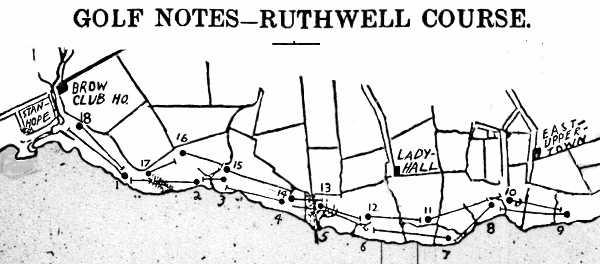
Ruthwell.
Ruthwell Golf course
Scotsman April 10th 1893
New Courses In Dumfrieshire
Formation
A party of Dumfries gentlemen have resolved to form a new golf course on the fore-shore of the Solway at Ruthwell, in consequence of the extent to which the Kingholm course at Dumfries is now crowded, particularly on Saturdays. A new club has also been formed at Thornhill, and it is intended to form a course near to the railway Station.
Ruthwell Golf Course
Club. Founded 1893. An 18 hole course at Brow, laid out by Willie Fernie.
The Ruthwell course lies along the northern shore of the Solway for the best part of two miles, and few courses present a greater opportunity for extensive brassy play. The turf is of the finest quality, and the putting greens are ample and in excellent order. Although the ground is flat, obstacles in abundance are well distributed over the course. The sea is a hazard throughout the outward journey. The teeing grounds are so placed that a foozled drive is heavily punished. The first tee is close to the hamlet of Brow. A deep ditch cuts obliquely across the line to the green, forming a continuous hazard. The distance is 350 yards to the hole, whose par value is five. The second is an extremely attractive hole. The player encounters an ancient sea-wall, an arm of the sea, an acre of shingle, with a ditch to guard the green. This also is a good five. The third is a thoroughly sporting hole, being guarded by a watercourse on three sides. As it is an easy cleek shot, a three will represent good golf. Splendid lies are obtained all the way to the next hole. The fifth green is 170 yards from the tee, but as it is surrounded by broken ground it usually costs four strokes. Good play should secure the sixth in four. The seventh, 525 yards in length, gives ample scope to the long driver. The sea forms a continuous hazard, and a six is satisfactory play. Correct golf should enable the player to hole at each of the eighth and ninth greens in four. Number 10 traverses similar ground but traverses an ancient salt-pan does admirable duty as a hazard in front of the hole, which should be done in six. The road to the 11th hole is much broken by creeks and channels, so that a seven is not out of the way. The next is 340 yards from the tee. If the player gets his drive well away he should have no difficulty in holing out in five. No 13 is guarded on all sides by ground much cut up by channels, and usually requires a four. The 14th is an interesting hole, and good players should record a three here. There is a capital turf all the way to the 15th green. A six represents accurate play. No 16 may be reached from the tee. It is well guarded by a yawning bunker, and its par value is four. The distance to the 17th is 400 yards. Although the ground is to the rough side, good lies are possible, and the golfer who records a five need not grumble. Another five should be sufficient for the home hole. The course has been well laid out. There is no crossing, and there is a pleasing variety in the disposition of the holes.” (GET 29.4.1898)
The Club was much affected by the opening of Powfoot GC in 1903. Last mention 1905
